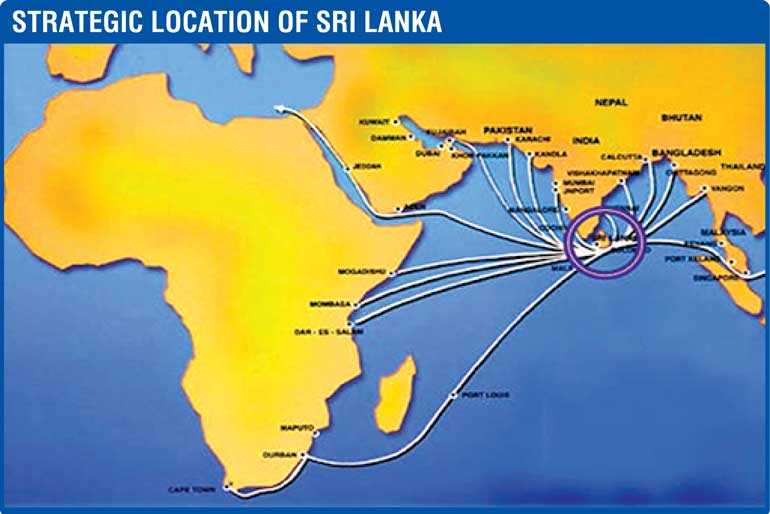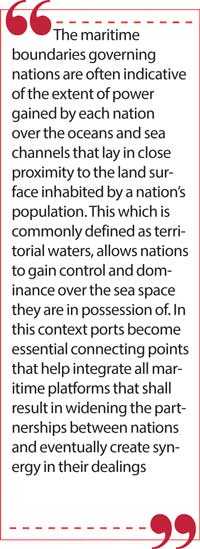Monday Apr 07, 2025
Monday Apr 07, 2025
Thursday, 12 March 2020 00:00 - - {{hitsCtrl.values.hits}}

The Pearl of the Indian Ocean as it may appear in the eyes of the global community, Sri Lanka is often identified as an island nation rich in strategic value, which often becomes appealing internationally for the plethora of beneficial avenues it opens up, to channel through and unleash the potential its  surrounding sea routes harbour.
surrounding sea routes harbour.
The chain of ports both in the form of natural endowments, as well as man-made establishments that have spread round the island along the coastal belt of Sri Lanka, is considered to be a national asset contributing towards boosting economic progression within the country, while also becoming a pivotal growth driver enabling the strengthening of international sea route connectivity, leading towards enhanced integrated maritime corporation.
Being in possession of three large international ports namely: Port of Colombo, Port of Trincomalee and the Port of Hambantota, which constantly offer multiple economic growth prospects, the maritime sector of Sri Lanka is making strides and moving forward to help spur international trade and other oceanic activity. The maritime boundaries governing nations are often indicative of the extent of power gained by each nation over the oceans and sea channels that lay in close proximity to the land surface inhabited by a nation’s population. This which is commonly defined as territorial waters, allows nations to gain control and dominance over the sea space they are in possession of. In this context ports become essential connecting points that help integrate all maritime platforms that shall result in widening the partnerships between nations and eventually create synergy in their dealings.
As a neighbouring nation, the ties of friendship Sri Lanka shares with India have been long standing and multi-purpose driven. In the maritime domain there are abundant commonalities we share as nations, to be able to interact with each other and be associated with efforts initiated by each party. However as we continue to move along 2020 and beyond, it is timely that we begin to draw greater attention to the potential benefits the nations may avail from the maritime sector. When observed from such a perspective, the availability of port led regional connectivity and development opportunities are plentiful. Sri Lanka’s stance in this context is multifaceted and provides a unique platform for the international community to become beneficiaries of.
A location that offers strong connectivity channels
Being positioned in a location that offers strong connectivity channels towards drawing together many international shipping routes, can be considered as a pivotal factor, which makes Sri Lanka stand out for the potential opportunities its ports could offer. Furthermore the speedy development that is taking place to improve the shipping logistics infrastructure facilities in and round the main ports of Sri Lanka, is allowing the expansion of existing terminals and building of new terminals with enhanced capacity that could easily handle the largest categories of vessels.
The changing nature and culture of the global shipping trade have allowed larger vessels to call on fewer hub ports. At a time when global shipping operations are being largely diverted towards Asia, Sri Lanka has now become a transit hub that remains tailor-made to meet the demands of the shippers and global trade partners.
Furthermore the initiatives undertaken by the Government of Sri Lanka to expedite its off-shore hydrocarbon potential is also gaining attention, as a result of the development efforts being concentrated in the domain of port led growth. Therefore such branches of activity which deal with sea based affairs, will certainly be benefited by the advancements that are taking place in the port based sphere of work.
As the Indian Ocean region continues to grow at a rapid pace, it is expected to contribute 22.1% of the World GDP by 2025. Sri Lanka as an island nation, while its economy is heavily reliant on the inflow of maritime trade revenue contributions, if maneuvered carefully the nation may certainly be able to offer port driven growth opportunities, to further strengthen regional ties of economic corporation. Widely focusing on projected trade oriented growth prospects, the Sri Lanka Ports Authority (SLPA) has clearly envisaged the two-way flow of business activity, that shall take place as a result of the capacity and efficiency enhancement strategies, which the Sri Lanka Ports Authority (SLPA) intends to initiate as a part of the National Port Master Plan.
The port of Colombo which was able to secure a milestone achievement of being able to handle a total of seven million TEUs in 2019, was placed 11th in the Global Port Connectivity Index and was also considered the best port of connectivity in Asia in 2019. Moreover during the same year, the Port of Colombo was also positioned 22nd in the World Container Port ranking, which communicated to the international parties, the promising opportunities such an island nation shall create to help extend the reach of off-shore business activity.
Tandem modernisation plans
However the National Port Master Plan formulated for the next 30 years, will certainly pave the way towards sustaining the on-going development, which the Port of Colombo is presently being benefited from. Setting in tandem modernisation plans for the purpose of improving the level of efficiency improvement of the East Container Terminals (ECT 1 and 11), West Container Terminals (WCT 1 and 11), SAGT 11 and the JCT are under way, the execution of which is expected to offer a capacity of 18 million TEUs by 2035.
Furthermore a Memorandum of Cooperation (MOC) has been signed by Sri Lanka with India and Japan for the purpose of developing the ECT. However, its outcome is intended to materialise by 2020. As agreed while the full ownership of the terminal shall remain with the SLPA, as stipulated in the MOC 51% of the terminal operating company will be transferred to the SLPA when formed.
The Port of Hambantota has begun gaining precedence as a lucrative window of connectivity that would become instrumental in diversifying the array of port-related services it could extend to many branches of economic activity. The envisioned outflow of results of the Road and Belt Initiative launched by China however, may certainly become a value addition to further enhance the productive functioning of the Port of Hambantota that will further benefit the sea channels which traverse Eura Asia.
Moreover, the Port of Hambantota is an all-purpose investment made, that is able to cater to requirements of many sectors in the off-shore arena. The emerging off-shore exploration sector of Sri Lanka, is one economic unit that shall benefit greatly by the efficient performance of the Hambantota port operations.
Immense emphasis has also been placed on the development of the Trincomalee Port, by adding novelty to the concept of Port Development. The anticipated transformation, which is in progress as an undertaking initiated by the SLPA, is intended to convert the Port of Trincomalee to a Megapolice centre enabling the port to function as an export hub. However for the primary purpose of allowing increased cargo handling capability, the Trincomalee Port was equipped with night navigation facilities in 2019, while also introducing a new radar system for monitoring all vessel movements.
The development tasks undertaken of this nature during 2019, was financed by a grant of $ 8.95 million offered by the Japan International Cooperation Agency. As the Port of Trincomalee is considered to be the largest port of all ports located along the coastal belt of the island, the SLPA is moving forward in leaps and bounds to convert the location to an industrial hub, that could make best use of the available land and water area of the Trincomalee Port and further enhance the spectrum of international trade operations Sri Lanka engages in.
As growth strategies are being concentrated in the areas of port development expansion work, quite mandatorily the SLPA is also keen on capitalising on both the Galle harbour and the North Port, which are intended to carve a different dimension of improving channels of regional connectivity that may eventually bring nations together across oceans. While holding on to such aspirations, the Government of Sri Lanka at present is also assessing the possibility of allowing the Galle Harbour to emerge as a tourist attraction, which in the long run will help continue to tap its potential as a natural harbour.
Moreover, feasibility studies are being conducted to learn how well the North Port Project could be implemented and made functional. However it has been observed that, such implementations may eventually be able to add 10 million more TEUs to the existing capacity by 2040.
Move forward
In order to be able to keep up the pace and move forward firmly to grow into a regional connectivity hub, Sri Lanka has further advanced the extent of port-oriented services being provided, with the primary purpose of creating a friendly environment for carrying out shipping operations conveniently. Stretching the entire network of logistics, which links together the functional areas that facilitate the provision of port driven services is a mandatory factor, the SLPA and the relevant regulatory authorities are beginning to address and deal with responsibly.
The growing support extended through multi-modal transportation systems, where air connectivity channels are also becoming readily available, has now begun to play a vital part in facilitating all logistics processes tied to shipping activities.
Adoption of digitised services enabling the rendering of all related services under one roof, while putting to practice the single window approach, allows the service providers to integrate their systems and work collectively to meet the expectations of the service recipients. While regulatory compliance has become a priority mainly in port related international engagements, policy revisions are due to be introduced to make the existing regulatory regimes applicable in these areas more investor friendly.
Attaining desired results requires collective effort
The way forward towards attaining desired results as a nation, often requires a collective effort to be concentrated in the relevant areas. Sri Lanka therefore, in this context has already commenced adopting a forward driven approach. Particularly several key areas have been identified as factors of growth and if utilised optimally, would bring in greater benefits to help transform the maritime sector of Sri Lanka, as a centre of regional connectivity. Developing the market which eventually enables the creation of business opportunities, is a mandatory branch of work that should be addressed in multiple ways.
Enhancement of the industrial stream of activity, which is dependent on maritime operations that will further facilitate the ease of carrying out international business operations, is a priority which should be given substantial consideration in this regard. The service providers of this industry should be offered opportunities to merge into the system, to help open the sector for engaging in international trade operations.
Furthermore the continuous infusion of a blend of best suited technology and supporting infrastructure, should be practiced to upgrade the quality of services being provided and to also remain on par with changing trends of the global maritime arena. Capacity building strategies to create a talent pool that may help steer the sector in viable directions should be enforced. Knowledge sharing and employment creation are two fundamental components to be worked on, the outcome of which will further facilitate the process of producing professionals who may easily be able to lead the sector. Sri Lanka however is already moving along this path, where several educational institutions have undertaken the responsibility of accomplishing this mission.
An economic unit seldom relies on its financial strengths to remain as a going concern. Similarly, attaining success as a unit will heavily depend on how well the port and maritime sector is able to sustain its financial stability. The inflow of funds that support the speedy and continued development of port driven operations, should therefore be an aspect to assess and implement to derive optimum economic gains. The SLPA along with other relevant institutions, have initiated efforts to seek opportunities that will provide suitable arrangements of funding enabling the initiation and sustenance of port oriented undertakings.
Nevertheless introducing the Private Public Partnership (PPP) concept as a stepping stone to begin moving steadily in this direction, could be a timely approach Sri Lanka as a nation would benefit from if implemented. Supporting policies are vital to be enacted, to define the ideal framework within which the port and maritime industry should function. The need still prevails to formulate tailor-made comprehensive policies in certain identified areas that will facilitate the process of sectoral growth to help attract a larger quantum of investment towards the sector.
The Export Development Board of Sri Lanka as a Government institution vested with the responsibility of executing plans tied to the fulfilment of such purposes, at present is working on conceptualising the framework of off-shore engineering and maritime sector development, which in the long run could be built in to the national development plans and agenda.
A mission can only be accomplished, when plans envisaged would unfold rightly and goals envisioned would be attained in due course, that will help complete the undertaken tasks navigated towards harnessing the economic value and strengths of endowments, a country possesses. The ports of Sri Lanka we shall therefore define as growth propellers, if maneuvered well will certainly fuel and steer the economy along pathways, which may enable the nations of the world to make best use of its sea routes.